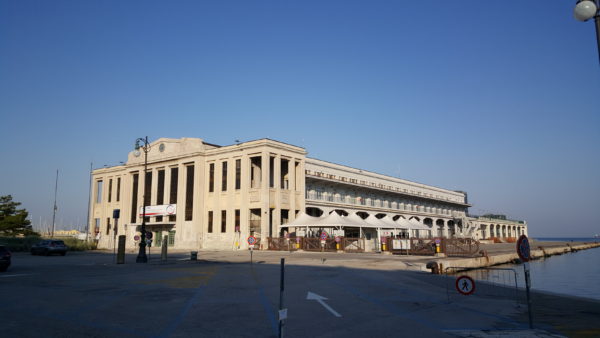
What did I learn from the 2016 annual European Meteorological Society (EMS) conference that last week was hosted in Trieste (Italy)?
I think the biggest news from the conference was that new reanalyses are soon to be released by the European Centre for Medium-ranged Weather Forecasts (ECMWF). One new product known as ERA-5 will replace the older called ERAINT, and preliminary results suggest a significant improvement in addition to higher spatial resolution. Check this webportal for ECMWF’s different reanalysis products. By the way, the naming convention of these reanalyses is rather strange and seems to defy any logic (first there was ERA-15, then ERA-40, followed be ERAINT, ERA-20C,…).
A coupled reanalyses known as CERA-20 was also presented, which breaks with the traditional atmosphere-only products. A coupled assimilation scheme for both atmosphere and ocean seems to give better quality and more consistent results.
Some of the results presented at the conference involved trends in temperature and precipitation statistics, and we are now seeing more intense rainfall. This is not entirely new, but we are getting a clearer picture on intense hourly rainfall. Also, observations suggest more drought in eastern Mediterranean, which is a region affected by both subtropical and mid-latitudinal weather phenomena.
If I were to pick one out of several good candidates, then perhaps the most interesting talk in the synoptic climatology session (for which I was co-convener) was on the ocean’s heat loss to atmosphere connected with surface turbulence. The message was that most of the heat exchange takes place over short time intervals, and that the most extreme magnitudes of heat exchange seem to be associated with high pressure system with cold air outbreak and an interaction with cyclones.
One tradition of the ESM conferences is to award the silver medal, and this year’s EMS Silver medal was given to Michel Jarraud, who, according to my notes, said that he regards meteorology as the leading edge in science and that numerical weather prediction is one of the great success stories. He also observed that weather was significant in the propagation of ebola, and that there is an urgency to act on climate change mitigation and adaptation. Another message was that we should not try to be perfect – it’s too costly and inefficient. Much of our knowledge is good enough for action on climate change. Another concern was about capacity building and that some nations soon may have meteorological services which will run without meteorologists.
Another impression was that climate adaptation seems to be stuck (also see recent post on mid-latitude storms) with limited resources devoted to climate services and little demand for climate information for decision making. There is still a question of added value for people who make the effort to incorporate such information in their business model or in governance (also see the post on added-value).
The conference had several parallel sessions and that spanned over a wide range of themes on applied meteorology and climatology, such as communication, TV meteorology, and forecasting, in addition to common climate research issues (check the conference website). I could not cover all, so I may have missed some of the interesting results.
Thanks for this report. Are the new reanalysis products more suitable for long-term studies, or do similar caveats about consistency over multi-decadal scales apply as with ERA40, etc? In particular, what about the new CERA20?
The “5” in ERA5 (no hyphen) indicates the 5th major reanalysis produced by ECMWF, if you start counting from the FGGE reanalysis, followed by ERA-15, then ERA-40, then ERA-Interim. The numbers in those names were supposed to indicate the length of the datasets in years, although ERA-40 actually ended up covering the 45-year period from 1957 to 2002. That naming scheme didn’t work for ERA-Interim either because it continues to be extended forward in time. More recently, inspired by the NOAA/CIRES 20th-century reanalysis project, ECMWF has started developing longer climate reanalyses at somewhat lower resolution and using fewer observations. CERA-20C (presented by Patrick Laloyaux
Layolauxat the EMS meeting) is the latest of those, it uses a coupled atmosphere-ocean model and a coupled data assimilation scheme.Oops! Can you please correct Patrick’s last name in my comment: Laloyaux, not Layolaux
I’ve always imagined cyclones to be mechanisms that transport heat from near surface towards the statosphere. It’s why they exist and it’s what they do, as I’ve seen them before. So it seems no surprising revelation to me that “… and an interaction with cyclones,” would be a component in the answer here.
Is this something novel to climate science considerations? Or just more a matter of more supporting evidence restating the obvious, but in more detail about exactly how?
[Response:The interesting bit was more the need for a presence of an anticyclone (high-pressure system), -rasmus]
Excellent little post – informative while subliminal in a sense that it reflects sterile status of ECMWF.
Dear Rasmus,
Thank you for pointing out on my talk on our research! Very goog surprise to me and the great feedback.
I will upload our presentation to the EMS web site, so it will be available for everyone.
Jon, indeed, for the formation of extreme turbulent surface flux from the ocean to the atmosphere high
pressure system required in the cyclones rear. At the same time, the role of extremes (higher than 90th percentile)
into the net oceanic heat loss to the atmosphere is up to 50% in the North Atlantic.
Many thanks again to everyone for the interest to our research!
There was another conference “1.5C conference on climate change”, organised by the Environmental Change Institute at the University of Oxford. Carbon Brief reports
Is this realistic? Is there any published material, peer-reviewed or otherwise?
With reference to my previous post.
Professor Friedlingstein has kindly replied to an email. Carbon Brief’s report does reflect his work. Writing it up is top of his list.